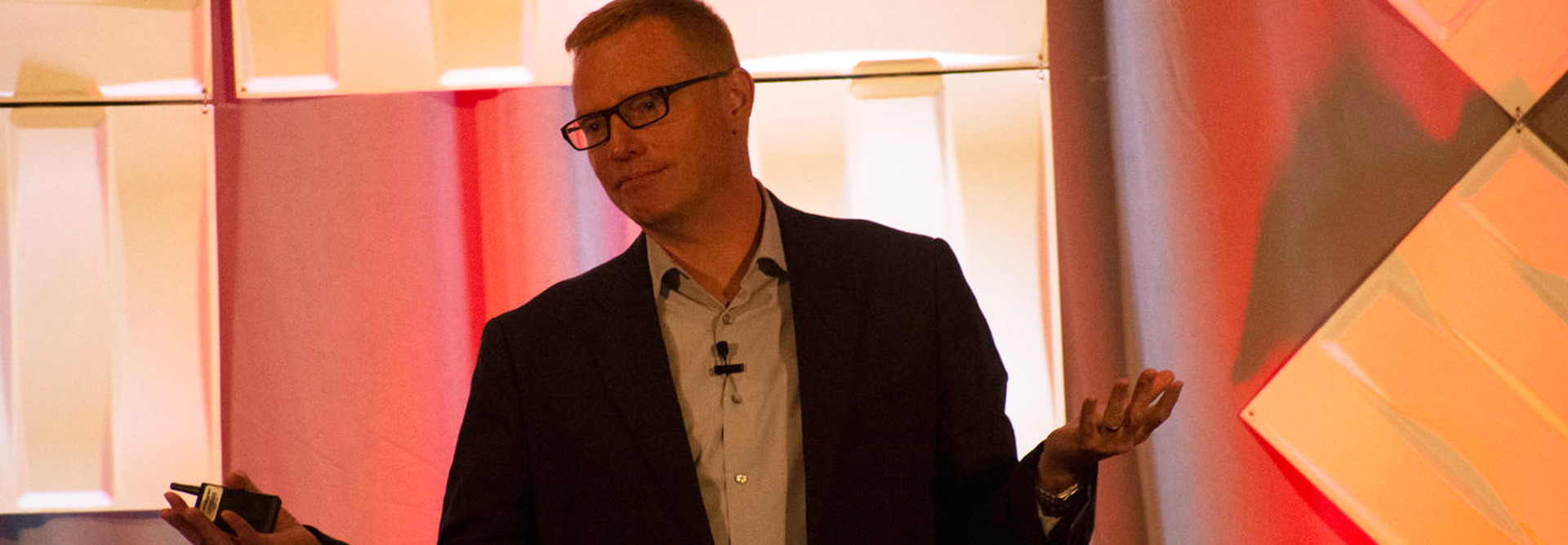What Are the 7 Hard Truths Every CIO Must Face?
Businesses, and in particular the IT departments of large businesses, must be wary of unintended consequences, particularly those resulting from the explosion of the Internet of Things (IoT), said Nigel Moulton, CTO for Europe, the Middle East and Africa at Dell EMC, during a presentation at the CDW Preparing for the Future SummIT in Nashville, Tenn., on Tuesday.
To highlight the ways in which the role of IT is changing, Moulton presented “seven hard truths every CIO must face.” Those truths included:
- You’re being disrupted as we speak.
- IT is still relevant but only if it adapts.
- Shadow IT has come out of the shadows.
- You can’t do everything in the public cloud.
- Prepare to be hacked.
- Running your IT department like you used to won’t work anymore.
- You have to become a data-driven business.
Across all of these statements, Moulton warned of disruption. Famously, the Eastman Kodak Company didn’t change in the face of digital photography, and its business suffered as a result. Once, the number of pictures you could take was determined by how many rolls of film you could carry, Moulton said. But with the rise of digital photography, the cost of taking one picture is basically the same as taking 100 or 1,000 pictures, and so the marginal cost of taking a picture became zero.
That change in cost structure created business opportunities, but it cost business that could not change. It also brought new issues, such as the burden of indexing digital photos, Moulton said.
“Disruption of the industry caused an unintended consequence,” he said.
SIGN UP: Get more news from the BizTech newsletter in your inbox every two weeks
Why Business Must Prepare for the Next Disruption
By thinking ahead, businesses can prepare for the next disruption, but they also must be agile. IT departments that are too siloed will hold business back, Moulton said. “Shadow IT exists because we are organizationally too rigid to respond in the way business is asking us to respond,” he added.
Companies must build bridges between their IT departments and what business actually requires. In doing so, they will break down silos, which inhibit innovation. A large IT department may have storage professionals and network professionals on the same staff, and they might not talk to each other, Moulton said. When they do talk, they may not speak the same language, as their terminology may be different. These silos create inefficiencies, he said. If you are in a siloed IT organization, you are not set up the way the business wants you to operate.
“A CEO may think this way: There are companies out there that make things happen. There are companies out there that watch things happen. And there are companies out there that say, ‘what just happened?’” Moulton said. “Nobody wants to be in the position of saying, ‘what just happened?’”
Moulton urged attendees of the Preparing for the Future SummIT to read The Lean Startup by Eric Ries, who describes the principle of the minimum viable product.
“Competitors will take a minimum viable product to market to challenge what you do,” Moulton said.
When a business is too closed, the pendulum of how people react swing toward shadow IT operations, where workers go around the IT department to get things done. When the silos come down and business is more agile, the pendulum swings the other way, and shadow IT is discouraged, Moulton said.
Opportunities Exist Because of Unintended Consequences
“The marginal cost of everything you measure is tending to zero,” Moulton said, emphasizing that the cost of measuring things is on the curve of Moore’s law, where the power of measurement increases every 18 months as its cost declines.
As predicted by research firm Gartner, the number of IoT devices in the world will increase to 20.42 billion by 2020. With the rise of IoT, everything connected can be measured because that capability is embedded in the technology, Moulton said.
“The consequences of not doing it are unacceptable,” he said.
As an example, Moulton shared that a digital pump company created an API to share data generated by its pumps. In doing so, the pump manufacturer discovered it knew more about consumption of cleaning chemicals than the chemical supply company did for a car wash chain in Berlin. With the information, the car wash and the chemical company could both improve monitoring consumption and scale that across the car wash’s locations.
That creates an opportunity when one looks at 60 car washes across Berlin, but it creates even more when one looks across 60,000 locations in 10 German cities, and even more still when one looks across 600,000 locations in five European countries. The businesses can distribute the chemicals more efficiently because of data collected.
“It creates a business opportunity because I can measure and monitor something,” Moulton said.
For more articles and videos from the Preparing for the Future SummIT, click here.
>>Download CDW's Modern IT Infrastructure Insight Report to learn more about how organizations are utilizing and benefitting from a hybrid IT approach.








